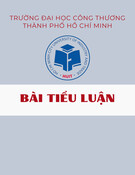
TRAN THI THU HUONG
SYNTHESIS OF SILVER, COPPER, IRON
NANOPARTICLES AND THEIR APPLICATIONS IN
CONTROLLING CYANOBACTERIAL IN THE FRESH
WATER BODY
Major: Environmental Technique
Code: 9 52 03 20
SUMMARY OF ENVIRONMENTAL TECHNIQUE
DOCTORAL THESIS
HaNoi - 2018
MINISTRY OF EDUCATION
AND TRAINING
VIETNAM ACADEMY OF
SCIENCE AND TECHNOLOGY
GRADUATE UNIVERSITY SCIENCE AND TECHNOLOGY
---------------------------

The thesis was completed at the Graduate University of Science
and Technology, Vietnam Academy of Science and Technology
Scientific Supervisor 1: Assoc. Prof. Dr. Duong Thi Thuy
Scientific Supervisor 2: Dr. Ha Phuong Thu
Reviewer 1:
Reviewer 2:
Reviewer 3:
The dissertation will be defended protected at the Council for
Ph.D. thesis, meeting at the Viet Nam Academy of Science and
Technology - Graduate University of Science and Technology.
Time: Date …… month …. 2018
This thesis can be found at:
- The library of the Graduate University of Science and Technology.
- National Library of Viet Nam.

1
INTRODUCTION OF THESIS
1. The necessary of the thesis
In recent years, pollution of soil, water and air has become a
serious problem not only in Vietnam but also in many parts of the
world in which the water pollution is more serious problem.
"Water blooming" is the development of microalgae outbreak,
especially cyanobacteria in fresh water bodies and often cause the
harmful effects on the environment such as: the water turbidity and
pH are increase, the levels of dissolved oxygen is reduce due to the
respiration or degradation of algae biomass and especially, the fact
that most cyanobacteria produce the toxicity high. The preventing
and minimizing the development of cyanobacteria is an important
environmental issue that need to pay the attention. The many
methods have been used such as: chemistry, mechanics, biology,
etc., but they are ineffective and expensive, affecting ecosystem
and conducting is difficult, especially in large water bodies.
Therefore, the search and development of new effective solutions
without secondary pollution and friendly with the environment are
increasingly focused research. Nanotechnology is the technology
relating to the synthesis and application of materials with
nanometer sizes (nm). At nanoscale, the material has many
advantage features such as: size is smaller than 100 nm, larger
surface to volume ratio, crystalline structure, high reactivity
potential, creating the effect of resonance Plasmon surface; high
adhesion potential and the nanomaterial was applied in various
fields such as: medical, cosmetics, electronics, chemical catalyst,
environment... For the above reasons, the thesis is proposed as:
“Synthesis of silver, copper, iron nanoparticles and their
applications in controlling cyanobacterial blooms in the fresh
water body” was selected to researched.
2. The objectives of the thesis
Research, fabricate and determine the characteristic of three
nanomaterials (silver, copper and iron) and evaluate the ability to
inhibit the cyanobacteria of nanomaterials in fresh water bodies.
3. The main contents of the thesis
- Fabricate and determine the characteristic of three
nanomaterials: silver, copper and iron.

2
- Investigate the ability to inhibit and prevent cyanobacteria of
three nanomaterials.
- Assess the safety of materials and their application.
- Experimental application of materials at laboratory-scale with
the Tien lake water sample.
5. The structure of the thesis
The thesis is composed of 149 pages, 10 tables, 62 figures, 219
references. The thesis consists of three parts: Introduction (3 pages);
chapter 1: Literature review (42 pages); chapter 2: Methodology (16
pages); chapter 3: Resutl and discussion (59 pages); Conclusion and
recommendation (2 pages).
CHAPTER 1. LITERATURE REVIEW
1.1. Introduction of nanomaterial
1.2. Introduction of Cyanobacteria and Eutrophication
1.3. Introduction of the methods to treat the toxic algae
contamination
CHAPTER 2. METHODOLOGY
2.1. The research subjects
2.2. The equipment is used in study
2.3. The methods for synthesis of materials
2.3.1. Synthesis of silver nanomaterial by chemical reduction
method
The silver nanomaterial was synthesized by chemical reduction
method, ion Ag+ in the silver salt solution is reducted to Ag0 by the
reducing agent NaBH4.
2.3.2. Synthesis of copper nanomaterial by chemical reduction
method
The copper nanomaterial was synthesized by chemical
reduction method, ion Cu2+ in the copper salt solution is reduced to
Cu0 by the reducing agent NaBH4.
2.3.3. Synthesis of iron magnetic (Fe3O4) nanomaterial by
simultaneously precipitation method
The iron magnetic (Fe3O4) nanomaterial was synthesized by
simultaneously precipitation method of Fe2+ and Fe3+ salts by
NH4OH.
2.4. The methods for determining the characteristic of material
structure

3
The morphology of the three nanomaterials is determined by a
number of methods such as: TEM, SEM, IR, XRD, UV-VIS, EDX.
2.5. The experimental setup methods
The experimental setup methods such as: culture of algae,
selection of nanomaterials, evaluation of the material toxicity, the
evaluation of the influence of nanomaterial sizes and the safety of
nanomaterials on microalgae and the experiment with the Tien lake
water sample were setup.
2.6. The methods of evaluating the effect of nanomaterials on
the growth of microalgae
To evaluate the effect of nanomaterials on the growth of
microalgae, the following methods such as: OD, chlorophyll a, cell
density, the methods for analysis of some environmental quality
indicators (NH4
+, PO4
3-) and SEM, TEM were used.
2.7. The method of statistical analysis
CHAPTER 3. RESUTL AND DISCUSSION
3.1. Synthesis of nanomaterial
3.1.1. Synthesis of silver nanomaterial by chemical reduction
method
3.1.1.1. Effect of the concentration ratio NaBH4/Ag+
The UV-VIS spectrophotometer (Fig 3.1) showed that the
nanosilver colloid was absorbed at the wavelengths about 400 nm
and the synthesized efficiency of silver nanoparticles was
maximum achieved at a ratio 1:2. TEM images (Figure 3.2)
showed that silver nanoparticle size was less than 20 nm.
Figure 3.1. The UV-VIS spectra
of nanosilver colloid depends on
the NaBH4/Ag+ concentration
ratios
Figure 3.2. The TEM images of
nanosilver colloid depends on
the BH4
-/Ag+ concentration ratio
M3
M4
M5
M1
M2














![Ô nhiễm môi trường không khí: Bài tiểu luận [Nổi bật/Chi tiết/Phân tích]](https://cdn.tailieu.vn/images/document/thumbnail/2025/20251011/kimphuong1001/135x160/76241760173495.jpg)







![Ứng dụng kỹ thuật trao đổi ion trong điện phân: Bài tiểu luận [chuẩn nhất]](https://cdn.tailieu.vn/images/document/thumbnail/2025/20250829/sonphamxuan1808/135x160/97341756442892.jpg)



